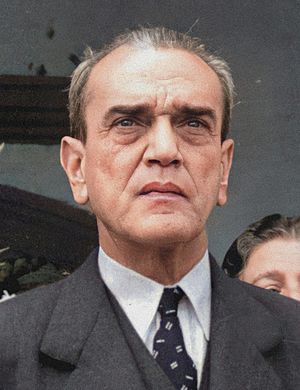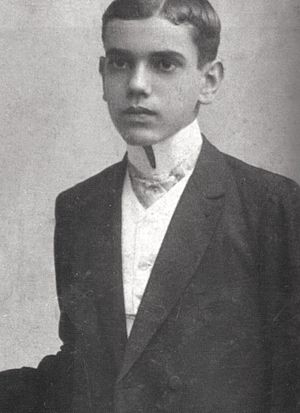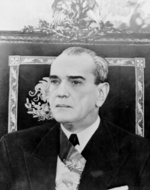Adolfo Ruiz Cortines facts for kids
Quick facts for kids
Adolfo Ruiz Cortines
|
|
|---|---|
 |
|
| 54th President of Mexico | |
| In office 1 December 1952 – 30 November 1958 |
|
| Preceded by | Miguel Alemán Valdés |
| Succeeded by | Adolfo López Mateos |
| Secretary of the Interior | |
| In office 30 June 1948 – 30 October 1951 |
|
| President | Miguel Alemán Valdés |
| Preceded by | Ernesto P. Uruchurtu |
| Succeeded by | Ernesto P. Uruchurtu |
| Governor of Veracruz | |
| In office 1 December 1944 – April 1948 |
|
| Preceded by | Jorge Cerdán Lara |
| Succeeded by | Ángel Carvajal Bernal |
| Member of the Chamber of Deputies for Veracruz′s 3rd district |
|
| In office 1 September 1937 – 9 September 1937 |
|
| Preceded by | Óscar Fano Viniegra |
| Succeeded by | Antonio Pulido |
| Personal details | |
| Born |
Adolfo Tomás Ruiz Cortines
30 December 1889 Veracruz, Veracruz, Mexico |
| Died | 3 December 1973 (aged 83) Veracruz, Veracruz, Mexico |
| Cause of death | Heart failure |
| Political party | Institutional Revolutionary |
| Spouses |
Lucía Carrillo
(m. 1915; div. 1935)María Izaguirre
(m. 1941) |
| Military service | |
| Branch/service | |
| Unit | Revolutionary Forces |
| He was the first Governor of Veracruz to serve a 6-year long term. | |
Adolfo Tomás Ruiz Cortines (born December 30, 1889 – died December 3, 1973) was a Mexican politician. He served as the President of Mexico from 1952 to 1958. He won the 1952 elections as the candidate for the main political party, the Institutional Revolutionary Party (PRI).
Ruiz Cortines was part of the Constitutionalist Army during the Mexican Revolution. He was the last Mexican president who had fought in this important historical event. Before becoming president, he worked in different government roles. He was an official in the Department of Statistics from 1921 to 1935. He also served as the Governor of Veracruz from 1944 to 1948. Later, he became the Secretariat of the Interior under President Miguel Alemán Valdés.
As president, Ruiz Cortines made big changes. He helped pass a law that gave women the right to vote in Mexico. He also started many projects to build new roads, homes, and other important structures. He believed in careful spending of government money. Many people remember him for leading Mexico's economy during a time of great growth, known as the "Mexican miracle." He is considered one of the most popular Mexican presidents of the 20th century.
Contents
Early Life and Education
Adolfo Ruiz Cortines was born on December 30, 1889, in the state of Veracruz, Mexico. His father, Adolfo Ruiz Tejada, passed away before he was born. His mother, María Cortines de la Cotera, raised him and taught him to read and write when he was just three years old.
His grandfather, José Ruiz Parra, was an important figure in Veracruz. He helped write the state's first constitution in 1824. He also worked to raise money for the Mexican Army during the French invasion. José Ruiz Parra cared deeply about educating local children.
Adolfo attended several schools, including the Colegio de los Jesuitas. He later studied at the famous Instituto Veracruzano. There, he learned about liberalism, which is a political idea about freedom and equal rights. This idea guided his political career. He also developed a strong love for baseball. He hoped to go to university, but the American invasion of Veracruz in 1914 stopped his studies. His first job was helping with accounting at a textile company.
Military Service and Political Start
Joining the Mexican Revolution
In 1909, Adolfo Ruiz Cortines became interested in politics after reading a book by Francisco I. Madero. Madero was a leader who opposed the government of Porfirio Díaz. When the Mexican Revolution began in 1910, Ruiz Cortines was inspired by leaders like Pascual Orozco and Pancho Villa.
In 1912, at age 23, he moved to Mexico City. After President Madero was killed, General Victoriano Huerta took power. Ruiz Cortines did not support Huerta's government. He joined the Constitutionalist faction, led by Venustiano Carranza. Ruiz Cortines mostly worked as a bookkeeper and paymaster for the army. He was known for his honesty and careful record-keeping.
Beginning a Political Career
After the revolution, Ruiz Cortines used his good reputation to start a career in government. He worked in the Department of National Statistics. He even took classes from Daniel Cosío Villegas, who later became a famous historian. Ruiz Cortines believed the statistics department should be independent.
His political career truly began in 1935, when he was 45 years old. He became a director in Mexico City during the presidency of Lázaro Cárdenas. During this time, he met Miguel Alemán Valdés, a young lawyer who would later become president. In 1940, Ruiz Cortines helped manage the presidential campaign for Manuel Ávila Camacho.
Later, when Miguel Alemán became Minister of the Interior, he asked Ruiz Cortines to be his assistant. This important role helped Ruiz Cortines gain influence within the Institutional Revolutionary Party (PRI). Because of his growing influence, the PRI chose him to run for governor of Veracruz.
Governor of Veracruz
In December 1944, Adolfo Ruiz Cortines became the governor of Veracruz. During his time as governor, he worked to improve public education in the state. He started new institutions, like the Technical Studies Institute, which offered practical education to help people improve their lives. He also founded the Institute of Anthropology and the State Planning Committee.
A very important change he made was to the local constitution. He changed it to allow women to vote in local and city elections. He also focused on building new roads and bridges to improve Veracruz's transportation system. This was important because Veracruz was one of Mexico's main ports.
President of Mexico
| Government of Adolfo Ruiz Cortines | ||
|---|---|---|
| Office | Name | Term |
| Foreign Affairs | Luis Padilla Nervo | 1 December 1952 – 30 November 1958 |
| Public Education | Jaime Torres Bodet | 1 December 1952 – 30 November 1958 |
| Finance and Public Credit | Antonio Carrillo Flores | 1 December 1952 – 30 November 1958 |
| National Defense | Matías Ramos | 1 December 1952 – 30 November 1958 |
| National Assets | José López Lira | 1 December 1952 – 30 November 1958 |
| Economy | Gilberto Loyo | 1 December 1952 – 30 November 1958 |
| Labor and Social Welfare | Adolfo López Mateos | 1 December 1952 – 17 November 1957 |
| Salomón González Blanco | 17 November 1957 – 30 November 1970 | |
| Health | Ignacio Morones Prieto | 1 December 1952 –30 November 1958 |
On October 14, 1951, Adolfo Ruiz Cortines was chosen as the presidential candidate for the Institutional Revolutionary Party (PRI). Since the PRI was the main party, his victory was expected. He officially became president on December 1, 1952.
Domestic Policies and Changes
After some past issues with government spending, Ruiz Cortines wanted to make the government more trustworthy. His main goals were "austerity and moralization," meaning careful spending and honest behavior.
He controlled government spending very strictly. He supported building many new roads, railways, dams, schools, and hospitals. He also started a plan called "March to the Sea." This plan aimed to move people from crowded highland areas to the coast. The goal was to better use and develop the resources along the sea. As part of this program, malaria was completely removed from some areas.
President Ruiz Cortines also created the Rural Social Welfare Program. This program worked to improve the lives of people living in the countryside. He also encouraged the fair distribution of land. Large foreign-owned lands were taken over by the government for public use. He also started the Farm Security program to help farmers when natural disasters happened.
One of his most important actions was to change Article 34 of the Mexican Constitution. This change gave Mexican women equal political rights with men, including the right to vote. He also created the National Housing Institute to help build more homes for people. He supported industries, especially small and medium-sized businesses. He also helped start the petrochemical industry and created new jobs.
Recognizing new technologies, he created the National Nuclear Energy Commission. This was to make sure Mexico kept up with advances in nuclear energy. He greatly improved primary and secondary education. He especially supported polytechnic universities, which focus on technical skills. He also provided funding to the National Autonomous University of Mexico (UNAM) and other universities across the country.
Another key goal was to improve the health of Mexicans. He fought against child malnutrition and started vaccination campaigns. Ruiz Cortines focused on social problems and brought an era of careful spending to the government. He changed laws to make public servants more responsible and honest. He created a law that required government workers to declare their wealth before and after their time in office. This helped fight against illegal enrichment and corruption.
His government worked to reduce public spending and strengthen the country's finances. These policies led to a stable economy and high growth rates in the 1950s. For the first time in many years, the Mexican government had more money than it spent. However, in 1953, private businesses invested less, and Ruiz Cortines lost some popularity. He then changed his policies to boost production. In April 1954, the value of the peso changed from $8.65 per dollar to $12.50 per dollar.
By the end of his term in 1958, he had faced some challenges. These included conflicts with farmers, teachers, and railroad workers' unions.
International Relations
During Ruiz Cortines's presidency, Mexico had a cautious relationship with the United States. He did not want Mexico to make agreements that would force it to join international wars. He completed projects like the Falcon Dam, which was built with funds from both Mexico and the United States.
In 1956, Ruiz Cortines met with US President Dwight Eisenhower and Canadian Prime Minister Louis St. Laurent. They discussed issues like immigration, economic cooperation, and fishing in coastal areas. Overall, President Ruiz Cortines's foreign policy was careful and respected the independence of other nations. He wanted Mexico to have closer ties with other countries in Latin America. He also sought to strengthen Mexico's role in the Organization of American States (OAS).
Life After the Presidency
On December 1, 1958, Adolfo Ruiz Cortines handed over power to the next president, Adolfo López Mateos. After this, he completely retired from public life. In his final years, his friend Manuel Caldelas García lived with him in Veracruz and helped care for him.
On December 3, 1973, Adolfo Ruiz Cortines's health became very serious. He passed away at 9:05 AM on that day, at the age of 82. The cause of his death was heart failure due to hardening of the arteries.
See also
 In Spanish: Adolfo Ruiz Cortines para niños
In Spanish: Adolfo Ruiz Cortines para niños




